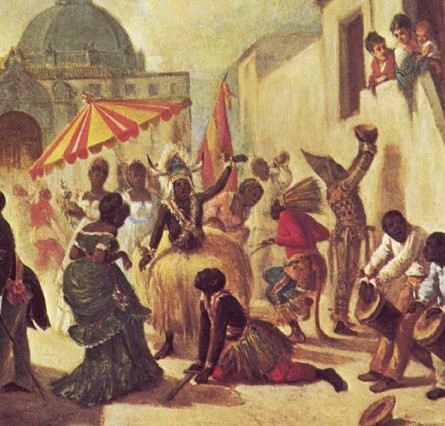Viva la Fiesta! : The Complex History of a Cuban Tradition
 Fiestas abound in Cuba year-round, and July is no exception. This month is particularly fiesta-centered in the nation’s second-largest city, Santiago de Cuba, where the Fiesta del Fuego has just wrapped up and the Carnival de Santiago de Cuba is about to begin, overlapping with the national celebration of Fidel Castro’s revolution on July 26. Exporters of Cuban culture, particularly the tourism industry, tend to portray such events as evidence that Cuba is a cultural melting pot, an idea supported by the fact that, historically, the island nation has one of the most ethnically diverse populations in the western hemisphere.
Fiestas abound in Cuba year-round, and July is no exception. This month is particularly fiesta-centered in the nation’s second-largest city, Santiago de Cuba, where the Fiesta del Fuego has just wrapped up and the Carnival de Santiago de Cuba is about to begin, overlapping with the national celebration of Fidel Castro’s revolution on July 26. Exporters of Cuban culture, particularly the tourism industry, tend to portray such events as evidence that Cuba is a cultural melting pot, an idea supported by the fact that, historically, the island nation has one of the most ethnically diverse populations in the western hemisphere.
While this image isn’t untruthful, it does oversimplify the role that fiestas have played in Cuban culture for over three centuries. In his new study Cuban Fiestas, Roberto González Echevarría argues that, while the fiesta has served as a unifying force, it has also served to create and maintain a series of carefully balanced power structures within Cuba. The fiesta does not represent “a completed synthesis of cultures yielding a nationality. There is no benign exchange of cultural traits or elements in the fiesta, but a barely deflected or sublimated violence by which relations of power are negotiated symbolically.”
The history of violence underpinning the Cuban fiesta is complex, and González Echevarría addresses and deconstructs each of its elements with care. His narrative keeps to a basic chronology, beginning with the arrival of Spanish conquistadors in Cuba in the sixteenth century and ending with the political unrest surrounding Castro’s contemporary government. Numerous details emerge that speak to the seemingly paradoxical role the fiesta played (and still plays) as a vehicle for both the expression and sublimation of hostility. For example, González Echevarría notes that seventeenth-century traders forced African slaves to dance and play drums to combat aggression and depression. “The fiesta as therapy to keep slaves alive and strong is at the foundation of African celebrations in Cuba,” he writes, “it is the seed of its contained and symbolized violence.” In “normal,” nonfestive time, the slaves would have been flogged mercilessly for such actions. The fiesta transformed rebellion into noisy, frenzied dancing, and the expression of cultural roots into an expression of subjugation.
By contrast, fiestas have also played an important role in actual rebellion. González Echevarría notes that the liturgical calendars and saints days that marked fiestas (an important part of Spanish Catholicism’s imposition of culture on Cuba’s native and enslaved populations) became convenient vehicles for setting off uprisings without raising the suspicion of Spanish authorities. During the nineteenth century, exiled political activists in the United States used fiestas to raise funds and rally support for the rebels at home. This continued into the twentieth century, and was joined by the Cuban government’s launching of its own employment of the fiesta as a unifying force through use of fiesta imagery in propaganda.
While he is invested in reinserting this darker history into our understanding of the Cuban fiesta, González Echevarría’s accomplishments in this text reach much further, working to elucidate why the fiesta has been able to function in such a controversial and multifaceted capacity within Cuban culture. To do so, he draws on a wide range of touchstones, including the histories of medieval carnival and of imperialism in Cuba, analyses of key moments in Cuban literature, art, and popular culture of the last three hundred years, and his personal experiences as a Cuban native in exile. Like the fiesta itself, his project is an act of nostalgia of the most intense sophistication. It both “recreates” a sense of wholeness from that which was never really whole and manifests a current state of brokenness.




